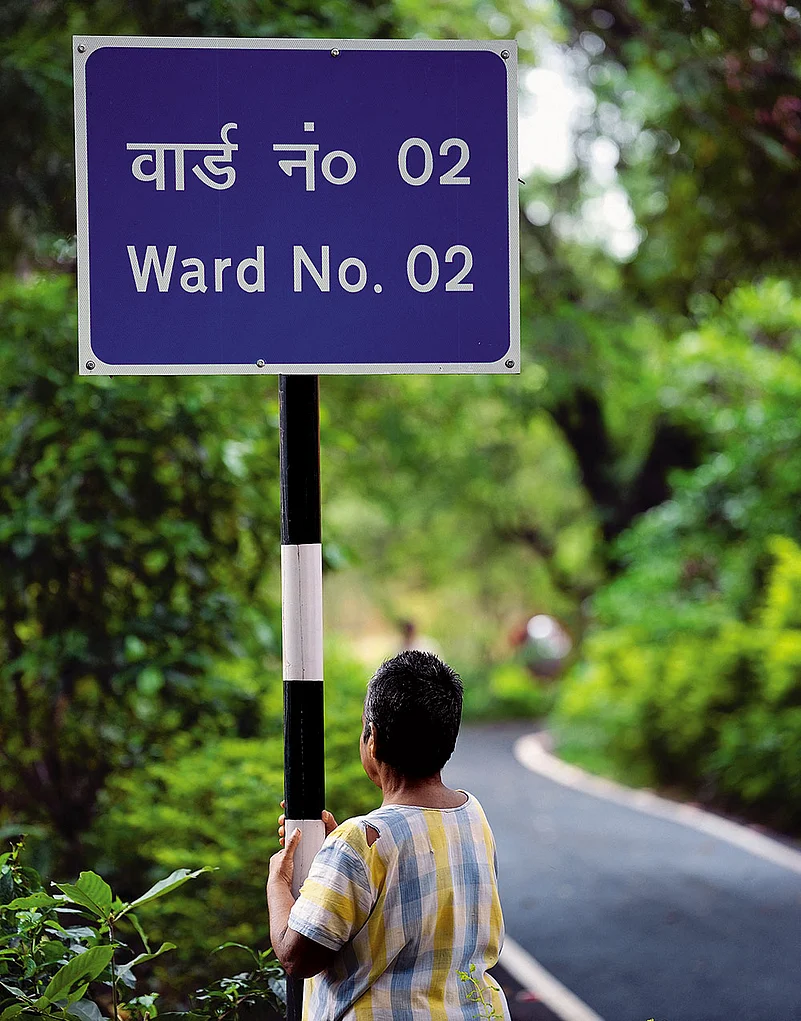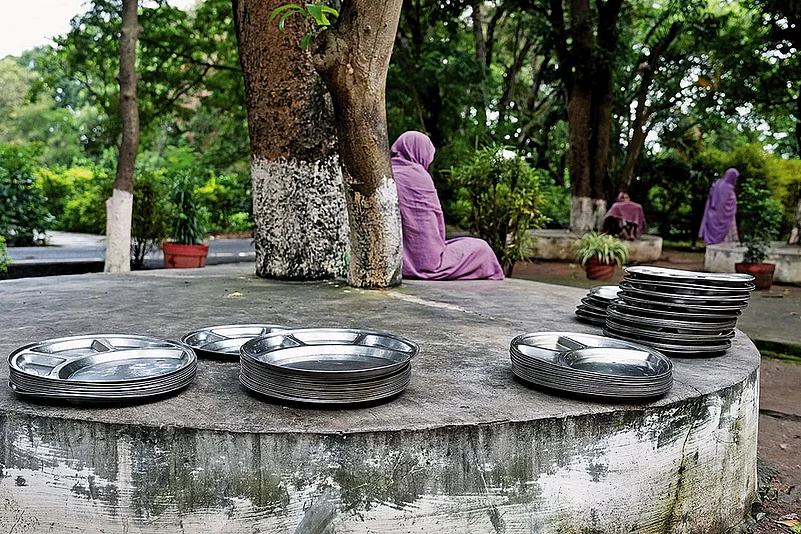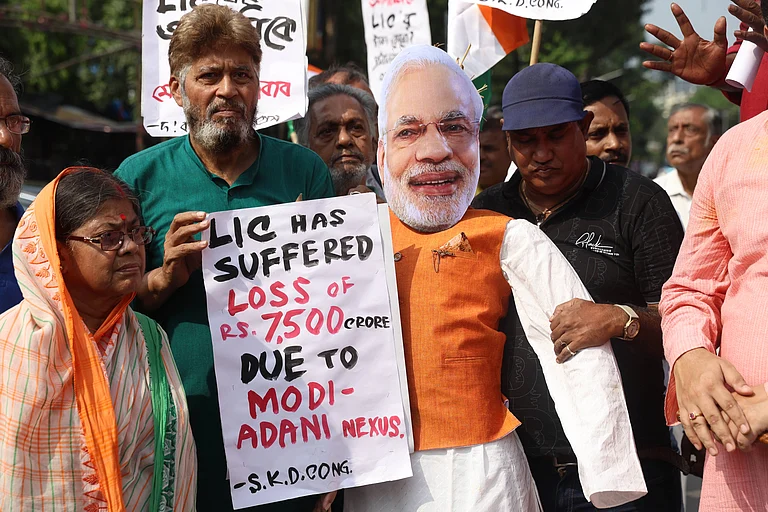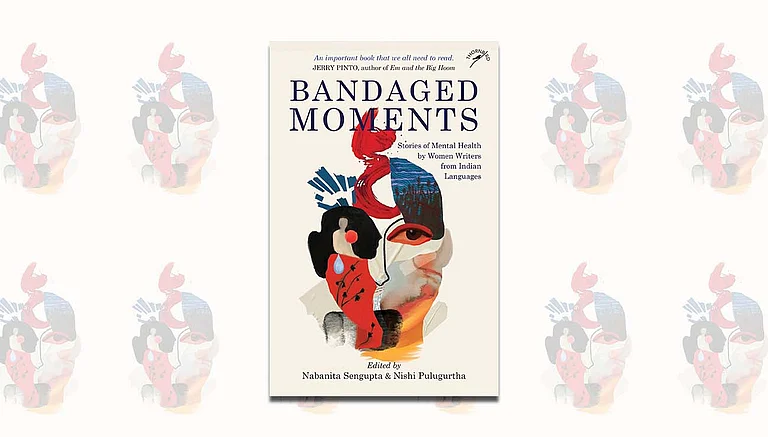
Mental Health Programme—launched in 1996—yet most districts still lack community-based mental health services
This narrative highlights how the social roots of trauma are neglected, with the health system treating symptoms, leaving the causes unaddressed, dissuading the mentally unwell from approaching the system.
Educated women are trapped by gender expectations—blocked by systemic barriers or deprioritised by the shortage of livelihood options.
Trigger Warning: This story contains mentions of suicide. Reader discretion is advised. If you or someone you know is struggling, please contact these numbers. | Helpline: iCall (9152987821) or AASRA (+91-22-27546669) — Available 24/7
Picture a woman, a single mother in her 30s, working as a cook in well-off homes. She feeds several families daily, but not one offers her a meal. Her day is long; she battles hunger, exhaustion, poverty. She decides to approach an NGO, The Banyan in Chennai, which helps homeless people with mental health conditions. She wants to know how she can cope with her troubles without falling apart. In a country with more resources, she might have had access to unemployment benefits or childcare support. In India, she faces near invisibility. What can The Banyan do?
Dr Sanjeev Jain, Emeritus Professor at NIMHANS (National Institute of Mental Health and Neuro Sciences) and associated with The Banyan says, “Situations like these are far too common in India, and they raise a crucial question—what are the goals of mental healthcare?” He recalls another case: a college student who studies by day and delivers food at night. He has no time to sleep, so he feels perturbed all day. Telling this young man, when he seeks therapy for his anxiety, to “just stop worrying” or “quit your job” is impossible—the student’s livelihood depends on it. His distress is not merely psychological but deeply entangled with survival and social inequality. So, how can a mental health policy help, when the root causes lie far beyond any doctor or clinic?
Stories like these reveal how mental health is inextricable from dignity, economic justice and a sense of community. That is why the Mental Healthcare Act (MHCA) 2017 is seen to mark a landmark promise for India’s mental health system. The law speaks the language of autonomy, rights and dignity, with provisions such as advance directives, nominated representatives and community-based care, aiming to move from coercion and control towards compassion and support. It acknowledges mental health as a fundamental right (as do Supreme Court rulings) and mandates timely access to care and protection against discrimination. Yet, for many, this legal framework remains a distant hope rather than a lived reality.
Amita Dhanda, Professor Emerita at the NALSAR University of Law and a long-time advocate for mental healthcare rights, says that India’s mental health system remains entangled in outdated binaries. “We talk in terms of sane or insane, curable or broken,” she says. “And as long as such binary thinking persists, empathy and understanding will remain elusive.” She points out that meaningful care must encompass the complexity of people’s lives, recognising neurodivergence—people whose brains work differently for their age—and distress as part of the human condition, not as medical diagnoses or, far worse, deviations.

Seen this way, if policy implementation is patchy or underfunded, and there are infrastructure deficits, those, too, are symptoms of the neglect of mental healthcare, not the cause. For instance, Mental Health Review Boards, the quasi-judicial bodies designed to protect patient rights and ensure timely reviews, are operational in only two states, Tamil Nadu and Goa. Without active Boards (section 73 of the MHCA), many legal safeguards, such as Sections 89 and 90 dealing with admission and supported admission for treatment—remain theoretical.
This erosion of rights compounds the trauma already suffered. When the promised care feels like fiction, the dissonance fractures hope for recovery. There are clear mandates under the MHCA and the long-standing District Mental Health Programme—launched in 1996—yet most districts still lack community-based mental health services (767 districts have been “approved” under the programme so far—which does not mean that the full range of services are present even in current districts).
But Dr Lakshmi Narasimhan, director, The Banyan Academy, poses an even more pointed question: “Mental health services don’t recognise the social world that people live in, so how can anyone expect to stay well?” (The National Mental Health Survey reported a 5.3 per cent prevalence of depressive disorders in India over a lifetime in 2015-16.)
She shares stories of people whose distress stems not from isolated illness but from the harsh realities of caste violence, poverty, family rejection and social exclusion. One mother institutionalised after childbirth—her baby taken away soon after signs of postpartum depression set in—is now back home, running a small business and supporting her children’s education. Yet, her husband and mother-in-law still brand her “mentally ill”, inflicting a deeper violence on her. She tells her family and counsellors, “The disorder is not mine—it’s your [the family’s] violence that broke my mind.”
“And she is right,” says Lakshmi, “She sweeps, cleans, cooks, travels to five villages for work and still her family stigmatises her.”
This narrative highlights how the social roots of trauma are neglected, with the health system treating symptoms, leaving the causes unaddressed, dissuading the mentally unwell from approaching the system. Dr Jain emphasises this gap. He recalls how many young patients recover from depression and anxiety—the most prevalent illnesses by far worldwide—with brief intervention, often without long-term medication. “Medication or therapy can help cross the distance from distress to comfort. But how do we ensure that someone stays well when their world is hostile?”
The law speaks the language of autonomy and dignity, with provisions such as advance directives and nominated representatives. Yet, for many, this legal framework remains a distant hope rather than a lived reality.
He says the problem begins with the default mode of care in India, medication, being both glorified—as in the case of costly weight-loss drugs—or derided, as are medicines that treat mental illnesses. In a pill-popping country where pharmacies excel at ‘giving something’ for a cold, fever or headache without prescriptions, people expect anti-depressants or anti-psychotics to feature rarely on the psychiatrist’s notepad. “Can you reconcile viewing some drugs as ‘trendy’ while wishing other drugs were not overprescribed?”
The bigger problem is that drugs are rarely integrated with community support. Though the MHCA mandates such support under Section 18, many receive pills but little else, and most not even that much. India thus overlooks how deeply mental health is interconnected with economic insecurity and the absence of welfare protections, apart from discrimination and oppression.
For example, young Indian women aged 18 to 25 face an alarming suicide risk—up to ten times higher than their counterparts in the United Kingdom. And in states with relatively high female literacy, such as Tamil Nadu and Kerala, female suicide death rates remain high. Educated women are trapped by gender expectations—blocked by systemic barriers or deprioritised by the shortage of livelihood options.
The dark history of psychiatry as a tool of social control rather than care lingers. Lakshmi recalls a mother whose son was lynched after he opposed a land grab by a dominant caste member in his village. The sight of her son hanging from a tree triggered a severe mental health crisis. A long period of medication ensued. When she returned to her old life, she still owed an old debt to the elite-caste family. Her neighbours refused to engage with her. The law prohibits caste-coloured violence and criminal trespass and murder—but the wheels of justice turn slowly, if at all. “If social wounds run deep, or the social fabric remains torn, what can ‘recovery’ mean?” says Lakshmi.
Her insight brings us back to clinical reality, where the real challenge is not just alleviating distress but sustaining recovery, in a society often more concerned with proving itself right than with enabling healing. According to the National Mental Health Survey, there were roughly 0.75 psychiatrists per 1,00,000 people in India in 2015-16. The India Mental Health Observatory (IMHO), said in a March study of the Union Budget 2025-26 that the Budgeted Expenditure (BE) for direct mental health services was 1.4 per cent of the total health budget. Of the Rs 1,004 crore allocated, Rs 860 crore was allocated to just one institute—NIMHANS.
The result is massive treatment gaps, with the NMHS reporting that nearly 83 per cent of those needing care probably go untreated. A paper on the ‘Prevalence of Major Depressive Disorder and its Determinants’ by Shromona Dhara, Joyeeta Thakur and others, published in July 2024, notes that Major Depressive Disorder had a 13.6 per cent prevalence among young married women and 5.1 per cent prevalence among unmarried girls.
These are not abstract statistics: they translate into lakhs across the country suffering silently, excluded from the mental healthcare net: “Psychiatrist availability varied from 0.05 per 100,000 population in Madhya Pradesh to 1.2 per 100,000 in Kerala,” notes a December 2023 paper published in the Indian Journal of Psychiatry titled ‘A Bird’s Eye View of the Mental Health Systems in India’, by Satish Suhas and others.
Syndromes of depression and anxiety are often self-limiting is the clinical observation—natural responses to life’s setbacks. You fail an exam, feel crushed, but resume preparations. You lose a loved one, suffer greatly, but bounce back. Healing begins as circumstances improve, with medication playing a supportive role. That said, clinicians have no surefire way to determine if a patient suffers from a temporary setback or lifelong malaise, which is why the profession leans on medication. Besides, why would someone visit a doctor, if not for pills or potions?
The real challenge is not just alleviating distress but sustaining recovery, in a society often more concerned with proving itself right than with enabling healing.
For this reason, experts and advocates call for a solution that “shakes up” the mental health system, saying it must extend beyond policies and clinics and become porous to social realities. Counselling alone, or just medication, are not enough as individuals carry the weight of trauma and collective pressures imposed by family, society, workplaces, politics, identity and history. “For example, we’re constantly told we were enslaved for 1,000 years—over 30 generations—when most of us barely know of our family history beyond two or three generations,” says Dr Jain. Such imposed historical anxiety makes people carry burdens that aren’t even theirs, making the social preoccupation with the distant past unhealthy. “People say, ‘We discovered trigonometry’—well, how about learning it today? Or ‘We invented the zero’—well then, don’t stop at zero.”
Beyond this, a collective misunderstanding of individualism continues to shape mental distress. This, too, fuels social anxieties, manifesting in phenomena like ‘Love Jihad’ or caste-based surveillance—where personal decisions are policed in the name of group loyalty.
Delfina Kanchana Sundar, an activist deeply engaged with the intersection of mental health, education and social justice, offers a powerful lens on why India’s mental health crisis extends far beyond clinical settings. Mental well-being is not something policies or laws alone can fix; it is rooted in the complex relationship between society and the individual. “In our system, students are told education is their only way out, so they carry this enormous weight of expectations, escape, survival. Those from marginalised communities—Dalit, Adivasi, Muslim, LGBTIQA+, or those from economically weaker backgrounds—face added pressure right from their school years. And the system piles on performance pressure without giving emotional support,” says Delfina, who works as a consultant with South India AIDS Action Programme, Chennai.
Delfina has seen how even the most “high performing” students are not okay. She’s watched them win awards, then cry in the washroom five minutes later.
“This is one of the things we cannot necessarily legislate about, but we can influence the situation by inculcating mental healthcare into the vision of those who frame educational policy,” Delfina says, advocating not for top-down changes to ‘fix’ things overnight, but solutions that answer the relevant conceptual questions, such as, what is holistic education and how does it factor in the mental development of the child?
“I don’t think we’re keeping track of their happiness. We only track grades,” says Delfina. “We must rethink mental healthcare as part of a larger social transformation project that values dignity, community and human connection.”
Dr George John, a retired clinical psychiatrist who spent his career in the United Kingdom before returning to Kochi, Kerala, 11 years ago, says any mental health law must account for a person’s possible loss of freedom. Put differently, patients must be able to access the least restrictive care option available—as the MHCA assures. “Most patients a psychiatrist would see are ordinary, everyday people, who must have a say in their treatment and care,” he says, advocating a more inclusive approach.
Ultimately, it is, as Professor Dhanda says, schools, hospitals, courts and prisons must be rethought to accommodate neurodivergence and distress—this isn’t about policies to ‘fix’ individuals through mandates and quasi-legal bodies but repairing broken structures.
The MHCA offers a roadmap, but remains largely unrealised, as rights exist but are inaccessible for most, since mental health is seen as a category unto itself, separate from or an exception to the reality people live in.
“Mental distress and disability are pervasive realities—if we frame our rules with inclusivity in mind, we may finally align the norms we create with the implementation we hope for,” says Professor Dhanda. But as long as these concerns are treated as special arrangements, we’ll continue to fall short. “When something is exceptional, you rarely allocate sufficient resources for it,” she adds.
Mental healthcare is also increasingly commodified by profit-making enterprises, making public systems crumble, prioritising the wealthy, when the goal ought to be universalisation. India is also caught up in debates on public versus private, universal versus targeted healthcare. “But these are distractions. What matters is whether the care is accessible and of good quality. Either build facilities to match promises in the MHCA, or provide insurance for all to access the care they need,” says Dr Jain. The imbalance in access to resources subjects many people with mental illness to substitute decision-making, often to family members, but also paid professionals.
More than anything else, until the world outside the clinic remains inhospitable, the “right” to mental healthcare will remain aspirational—and unrealised.
MORE FROM THIS ISSUE
Pragya Singh is Senior Assistant Editor, Outlook. She is based in Delhi








.png?auto=format%2Ccompress&fit=max&format=webp&w=768&dpr=1.0)

























